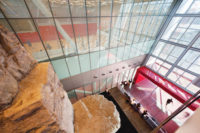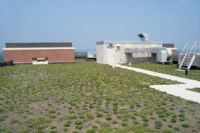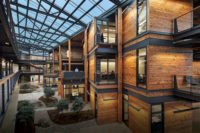A press release came my way back in August…actually a whole lot of press releases came my way back in August. This one in particular caught my attention. It began, “With millions of sports fans visiting LEED-certified green sports venues every year, the U.S. Green Building Council (USGBC) announced a collaboration with the Green Sports Alliance, a nonprofit organization supporting the development and promotion of green building initiatives in professional and collegiate sports.”
That’s right, the USGBC had put on its jock strap.
Okay, that’s a horrible metaphor (and a confusing visual), but the agreement underlines not only the importance of “greening up” every facility but also that every facility can be more sustainable. I wrote last year that stadiums, by their very nature, don’t lend themselves to sustainability. I stand by that statement; they use intense amounts of water and energy even when they’re unused (like my cell phone), which is most of the time (again, like my cell phone).
But as the USGBC’s partnership with the Green Sports Alliance shows, opportunities to invest in stadiums’ and athletic facilities’ sustainability exist. The following are examples of how some sports facilities have incorporated green, as well as some of the products helping these bastions of entertainment achieve their goals.
Palais des Sports Léopold-Drolet de Sherbrooke
Picture an average house. Not something with a completely tight envelope, but one of the many millions throughout the U.S. and North America that are closer to a HERS score of 100 than they are to zero. Now picture going for a spin on a go-kart through that house. What do you think running the engine inside would do to the indoor air quality? Nothing good, right? That’s similar to what happens with indoor ice rinks.
While the IAQ of ice arenas is typically better than the IAQ of a home where a pre-teen boy’s dream has just been played out, the air quality in ice rinks can be awful. So awful, in fact, that the EPA deemed it necessary to give them their own IAQ page. The usual suspects for poor indoor air quality are present, but running an ice resurfacer powered by an internal combustion engine really doesn’t help. And going out and buying a new machine that meets the EPA’s more stringent emission standards isn’t always possible. Even if it was possible, there are still other things that can be implemented in an ice rink to help improve indoor air quality. Such was the case of Palais des Sports Léopold-Drolet de Sherbrooke in Québec, Canada.
The remodel of this 47-year-old multipurpose sports arena called for the inclusion of CertainTeed’s AirRenew Extreme Impact gypsum board. AirRenew is designed to help improve air quality by removing VOCs from the air, specifically formaldehyde and other aldehydes. Since it’s going into some high-traffic areas, AirRenew Extreme Impact offers enhanced moisture and mold resistance as well as a specially designed fiberglass reinforcement to provide superior durability in areas prone to hard impacts and penetrations.
“We are happy that AirRenew was used on the renovation—as much for its air-clearing properties as for its longevity,” says Jean Désourdy, construction project manager of the city of Sherbrooke. “The refurbished stadium represents the high standards and pride we take in our city. We received very positive comments from visitors throughout the province for the achievement.”
It’s not a cure-all for IAQ ills, but it can take some of the load off of the mechanicals.
Marlins Park
Speaking of mechanicals, the home of the Miami Marlins is the first retractable roof facility in the world to earn LEED Gold. One of the main reasons for the retractable roof was to shield fans from the sometimes uncomfortable South Florida heat, humidity and afternoon downpours. The 2.8 million-square-foot ballpark uses demand-controlled ventilation technology coupled with CO2 sensors that constantly monitor the occupancy of the building. Energy savings are realized by continuously minimizing the ventilation air based on occupancy.
A majority of the cooling is generated by two large Trane water-cooled heat recovery chillers. Waste heat is consistently captured from the chillers to heat the ballpark’s domestic water. The energy savings are significant when, under full capacity, the domestic water PVI boilers serving the service level and main concourses can remain off for much of the time.
Trane energy recovery systems are used in the player locker rooms where the incoming outside air is pre-treated by the exhaust air streams, substantially reducing the load on the cooling coils.
Water is conserved on the site thanks to waterless fixtures such as Kohler and Zurn waterless urinals, Zurn low-flow toilets, Zurn lavatory faucets and Speakman low-flow showerheads. Site water consumption was further reduced through the use of native and adaptive plants and drip irrigation. In addition, effective strategies were implemented to control, reduce and treat stormwater runoff before it leaves the project site.
UTA College Park Center
On the University of Texas at Arlington (UTA) campus, the LEED Gold College Park Center provides a 7,000-seat venue for the UTA Mavericks basketball and volleyball teams—their first true home court. Additionally, the center’s sustainable landscaping sets it apart.
The Green at College Park in Arlington, Texas, was named one of the first certified landscapes by the Sustainable SITES Initiative (SITES), a rigorous new ratings system for site development. The inclusion of the new, SITES-certified 2.6-acre Green at College Park within the LEED boundaries makes it a leader in Texas and beyond.
HKS designed the site to restore natural habitats, maximize open space and manage hydrology. “A compact footprint for the arena creates an outdoor public room to the north and a naturally landscaped park along the east side that buffers the arena from the street,” says David Skaggs, AIA LEED AP, vice president, HKS Sports & Entertainment. “The park is planted with native and adapted vegetation able to tolerate both extremely wet and dry conditions. These plants absorb stormwater like a sponge, decreasing the amount of water flowing through the park and filtering much of the dirt and pollution, resulting in cleaner water leaving the site.”
Recycling Artificial Turf
Many places around the world have opted to stop worrying about watering their grounds altogether by getting rid of the grass.
The debate over synthetic turf versus natural grass can be as divisive as Michigan/Ohio State, Texas/Oklahoma, DH/no DH, and is pro wrestling a sport? For those owners locked in such a debate regarding natural or synthetic turf, a piece of news emerged in August that might tip the scales in favor of synthetic.
Much like how Kleenex became synonymous with facial tissue, AstroTurf had been used to describe artificial grass for years, regardless of the actual maker. The evolution of synthetic playing surfaces has evolved greatly since the first prominent installation in the Houston Astrodome in 1966. As owners have opted for more modern iterations, landfills were increasingly being filled with the old turf. The August news from the longtime manufacturer announced that it is now offering full field recycling.
According to the company, the proprietary recycling process uses specialized machinery to remove the infill. Afterward, the entire field is cut into manageable strips, rolled up, and shipped to AstroTurf’s recycling facilities in Dalton, Ga. There, the rolls are ground up, melted into pellets and re-extruded into new plastics. The key difference according to AstroTurf’s process and other recycling initiatives? All elements of the field are reportedly recycled.
Lincoln Financial Field
Football and baseball fans in Philadelphia know all about the “quirks” of artificial turf thanks to Veterans Stadium. The Vet was notorious for its poor playing surface, perennially drawing criticism from players and coaches.
Controversy over the playing surface for the Philadelphia Eagles was reduced considerably with the development of the team’s new home, Lincoln Financial Field. While some might still complain about the team’s playing surface (which is now a hybrid of grass and synthetic), the real focus of Lincoln Financial Field has been its attention to sustainability.
In an attempt to become the greenest stadium in the world, Lincoln Financial Field has incorporated a number of sustainable strategies, including food composting, planting trees to offset travel, the use of organic fertilizers and stocking the concession stands with bioplastics. Additionally, oil used in the fryer is shipped out to be made into biodiesel, which is then returned to fuel equipment.
The Philadelphia Eagles signed an agreement with NRG Partnership in 2012 for a unique renewable power installation. The system reportedly includes the largest solar power system in the NFL and in the Philadelphia area, with more than 11,000 solar panels and 3 MW of generating capacity. Solar panels along 11th Street and the south façade of Lincoln Financial Field will generate power and visually demonstrate the Eagles’ and NRG’s commitment to renewable power. Fixed solar panels in the parking lot generate the bulk of the clean, renewable power that helps to run the stadium all year long.
Additionally, 14 micro wind turbines were placed along the top of the stadium on the north and south sides. The new clean power equipment is positioned in a way that will not interfere with the fans’ enjoyment of the Eagles’ home games.
Estadio Nacional de Brasília Mane Garrincha
But Lincoln Financial Field faces some stiff competition in its goal of becoming the world’s greenest stadium, namely from a stadium in Brazil.
EcoArenas LLC and Cadmus Group Inc. worked closely together to help create the Estadio Nacional de Brasilia Mane Garrincha, which is expected to be the first LEED Platinum FIFA World Cup venue. This 70,000-seat stadium, which hosted the 2013 FIFA Confederations Cup in June and will serve as one of the prime venues for the 2014 FIFA World Cup, expects the LEED certification process to be completed in the first quarter of 2014.
While construction in Brazil, the World Cup and even LEED can stir up controversy, the project team on this stadium aimed to put to bed any concerns over its energy usage. The goal of the Estadio Nacional project was to create the first net-zero energy stadium in the world as well as a net energy producer.
According to current estimates, Estadio Nacional’s energy-efficient building design measures alone have resulted in estimated energy cost savings of 103,000 Brazilian Real (BRL). The stadium’s 2.0 megawatt (MW) solar photovoltaic (PV) system, will generate approximately 2,760,000 kWh/yr, to create an estimated additional cost savings of 702,000 BRL (2,760,000 kWh x 0.2652 $R/kWh plus demand reduction charges). The stadium itself will consume 1,910,000 kWh/yr; the excess energy produced by the PV system will be returned to the city of Brasília. The stadium has an estimated energy cost reduction, as compared to ASHRAE 90.1 – 2007 baseline, of 55 percent.
“Our hope is that a solar stadium will trigger investment in a decentralized, independent, renewable energy market for Brazil and change the way we design and operate buildings for good,” says Ian McKee, LEED AP, author of the CopaVerde Plan and sustainability director for the Estadio Nacional Mané Garrincha in Brasília.
The facility was designed with legacy operations in mind and will continue to be used as a sports and entertainment venue after the World Cup.
More and more stadiums are becoming greener in an attempt to benefit their locales by limiting the use of natural resources. However, there is still far more that can be done. It’ll be interesting to see what elements will be improved upon now that more people and organizations are getting into the game.






